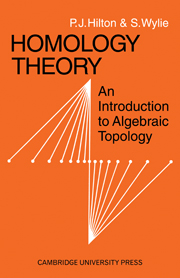Book contents
Background to Part II
from PART II - GENERAL HOMOLOGY THEORY
Published online by Cambridge University Press: 02 February 2010
Summary
In chapter 7 we shall make constant use of definitions and results from homotopy theory; they will also be used, but more sparingly, in chapters 8–10. This Background to Part II assembles the relevant facts about the theory. We reserve the title of ‘Theorem’ for those results which are substantial and difficult to prove; the proofs will be found in the references given. Propositions and corollaries should be deducible by the reader with the help of the sketched proofs which we append where necessary (in brackets).
Homotopy groups
Machinery. We recall that Vn stands for the n-ball, u21 + … + u2n ≤ 1 in Euclidean space Rn ⊂ H∞ and that Sn–1 stands for its frontier in Rn, the (n–l)-sphere u21 + … + u2n = 1. The point
lies in Sn–1 for all n ≥ 1 and is used as a base-point. Sn–1 divides Sn into two closed hemispheres En+, En−; En+ is that for which un+1 ≤ 0 (see fig. II. 1).
We use standard homeomorphisms h+ : Vn → En+, h−: Vn → En+ given by
II.1.1 (u1, …, un) h⁺ = (u1, …, un, ⁺ [1 – u21 – … – u2n]).
- Type
- Chapter
- Information
- Homology TheoryAn Introduction to Algebraic Topology, pp. 273 - 289Publisher: Cambridge University PressPrint publication year: 1960

